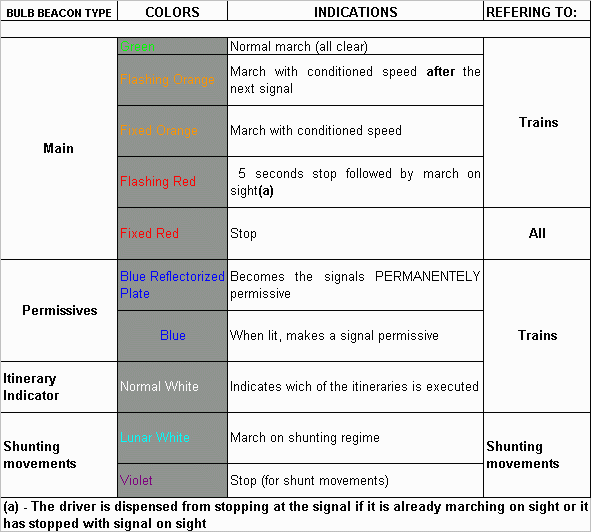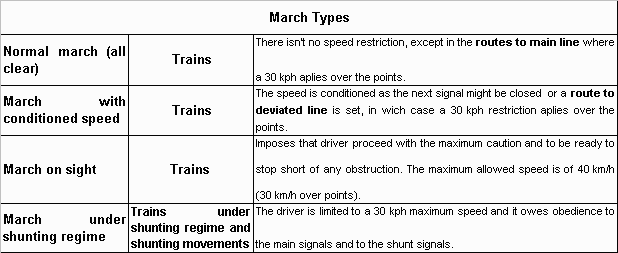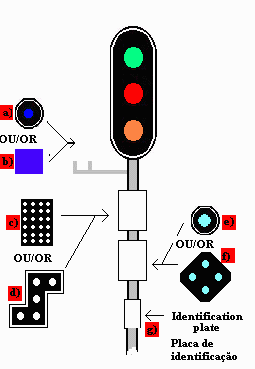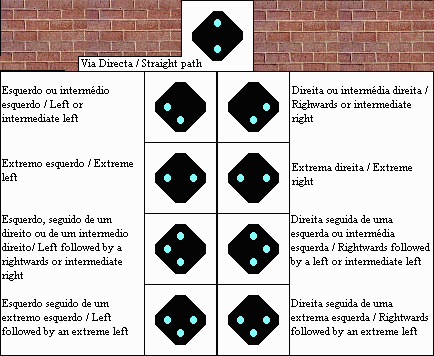Cascais Line
The Cascais Line runs parallel to the river Tagus / Atlantic
Ocean from Lisbon to Cascais and for several years (until 1976)
it was concessioned to the Estoril Society, wich turned that line
into a modern and efficient railway. For the the persons who know
CP's regulations dating from the 60's will find there lots of
resemblances with the Cascais line regulations, as it is simply a
non-evolved version of those regulations were for normal
direction working automatic block exists but for wrong line /
temporary single track working, staff is use. The major visibile
difference are the directional shunt signals! Also for a long
time a simple train speed control is used, wich consists on the
use of magnets wich are placed about 400 meters before each
signal or Level Crossing (LC). If the signal is closed or the LC
is broken or unmanned (at night) the magnet is activated forcing
the driver to take an action. (this system will be explained
ahead.) A curious fact regarding to the Cascais line is that it's
regulations are provisional since 1975!!!
Signalling
In The Cascais line, each colored bulb (or group of coloured
bulbs of the same color) is treated in an individual form as it
can be observed on the chart below.
A signal wich contains a main bulb, is considered to be a main
signal and a signal wich only contains shunt bulbs, is considered
to be a shunt signal.However a main signal might have shunt
bulbs(only the lunar bulbs are used as the stop is indicated by
the fixed red off the main signal) The Permissive bulbs / plates
allow that the train driver passes the fixed red after a 5
seconds stop. This plates do not have any other utility.
The direction indicators are allways formed by
groups of bulbs, forming either dashes or numbers. It's
indication it is only informative.



As said earlier, the main signals are the ones
the present, at least, a main aspect, independentely of having
shunt bulbs associated or not. This signals are in a general way,
"High" signals (with about 4 meters high) but in the
case of sidings wich are rarely used, the main signals are dwarf
type, in order to avoid confusions.
The main signals can be of two types:
- Permissive - when they are block signals, in
wich case they work automatically without human intervention.
They can be identified by the blue reflectorized plate with wich
they are identified.
- Absolute - wich are all the signals wich aren't
permissive. They are called absolute as they can order the
absolute stop (stop & stay). They can work automatically or
semi-automatically
This signals, according to it's equipment, are
identified as being of a certain type, as follows:
 PR type - Permissive Signal - Are the signals
equiped with the plate b)
PR type - Permissive Signal - Are the signals
equiped with the plate b)
A type - Absolute signals without shunt
bulbs - Are the signals wich do not have any of the equipments,
except the g) wich all have.
AS type - Absolute Signal with a simple
direction shunt indicator - Are the signals equipped with the
bulb e). if it is a dwarf ("baixo") signal, it
becomes an ASB type signal.
ASA type - Absolute Signals with a simple
direction shunt indicator e) and equiped with the blue(azul)
light a).
AM type - Absolute signals with a multiple
direction shunt indicator f). If it is a dwarf ("baixo")signal
it becomes an AMB type signal.
ANS type - Absolute Signals with numerical
indicator of "n" itineraries and simple
direction shunt indicator. - Only two of this signals exist, wich
are the home signals of the terminus stations (Cais do Sodré and
Cascais). For obvious reasons, neither this signals, neither the
preceeding ones are equipped with the Green light.
type ADS - Absolute signals with an
two ["dois/duas" (masc/fem)] direction indicator
and simple direction shunt indicator. - This signals can
only be found as home signals of the Semi-Terminus stations
(Algés, Oeiras and Sao Pedro do Estoril). The Semi-Terminus
stations of the Cascais line, are the stations were some trains
end their journey returning then to Cais do Sodré. For that they
are equipped with a central line in wich those trains are
stabled. The direction indicator only lits ( | or / ) when the
orange aspect is shown, as then green allways implies a straight
path.
The Main signals The main signals placed on the
main lines and the LC's are associated with a magnet, placed
about 400 meters before them. That magnet, when activated ,
forces the driver to slow down the train to under 30 km/h
acording to the following principles:
When a signal presents Fixed red or Flashing red, the
magnet associated to the signal is activated, actuating over any
train that passes over it (as long it has a receiver, wich all
do, except the rolling stock wich is "outsider" to the
line) in the following way:
- If the train passes over the magnet at over 60 kph, immediately
an emergency braking is provoked
- If the train passes over the magnet at under
60 kph, the driver has 12 seconds to take the train to under 30
kph
- If after 12 seconds the train is over 30 kph,
an emergency braking is provoked but if the train is under 30
kph, the system is reset to normal.
Besides a visual indication to the driver, also
a buzzer or a ringuing bell warns the driver of the above
timings.
As usually the magnet of a signal is placed right after the
previous (in some cases even about 50/100 meters BEFORE!!) as
soon the driver sights a yellow it makes a very strong braking as
if it passes over the magnet at over 60 kph...... . In the case
of an LC, all happens in the same way but without signals. In
order that an LC magnet is deactivated, at least three conditions
must be fulfilled:
- It must be working properly (automaticaly)
- The barriers must be lowered
- The LC has to be manned
If this three conditions are not
fulfilled the magnet is activated. It should be noticed that this
magnets are not complemented by visual signals, so the driver
only knows that something is wrong at the LC when the train is
braked by the system. The exception to this is between 10.30pm
and 6am, when the LC's become unmanned and therefore they must be
passed "marching on sight". Even so, sometimes some
drivers forget that fact and you see a train stopping in the
midle of nowhere in the middle of the night apparentely for no reason!!!
Shunt signals
As referred, this signals can either be of simple direction or
multiple direction, having only authority over trains wich are
shunting or under the shunting regime. This is one of the
characteristics of the Cascais line, the existence of shunt
signals where the shunting permited aspect not only allows the
shunting movement itself as also it indicates the direction of
it.
 Are generally used associated with Station entrance
main signals(home signals) and to protect shunting routes where
only a single direction is available.
Are generally used associated with Station entrance
main signals(home signals) and to protect shunting routes where
only a single direction is available.
 When more than one route is
available for shunting purposes, to protect them a multiple
direction shunt signal is used. This signals can also exist
isolated or associated with main signals, namely AM or AMB.
When more than one route is
available for shunting purposes, to protect them a multiple
direction shunt signal is used. This signals can also exist
isolated or associated with main signals, namely AM or AMB.
According to the litten lights a direction is given:

At the stations home signals, the oppening of the simple
direction shunt signals wich are associated to them obeys to
certain rules:
- Once open, the Shunt signal will only be
kept open for 60 seconds, after wich it will close again , if it
hasn't been passed by a train.
- If more than one train is aproaching to the
signal, only the closest one to the signal can pass it after it's
clearance. The following train will stop before the signal and
wait that the shunt signal closes. When the signal is reopened,
the driver is allowed to proceed , according to the presented
aspect (In Portugal, the Shunt allowed aspect only closes AFTER
all the train as passed the signal).
- After passing an home signal presenting
shunt allowed, the driver will stop at the platform, unless an
hand signal, allowing the driver to proceed is presented. (of
course the starter must be open).
If the Starter (Exit main signal) indicates the march in shunting
regime, the drivers will act in the following way:
- If the driver starts the train at that station or it has
entered into the station under the shunting regime, it will only
be allowed to proceed with the presenting of the right away
signal by the station master. But if it has passed the home
signal presenting an aspect wich referred only to trains, namely
Orange, Flashing red or Red + Blue, the right away of the station
master is dispensed..
17-05-2007





